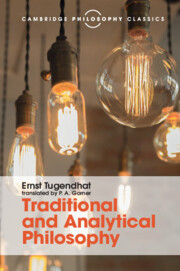Book contents
- Frontmatter
- Dedication
- Contents
- Preface
- Preface
- Translator's preface
- Part I Introduction: confrontation of analytical philosophy with traditional conceptions of philosophy
- Part II A first step: analysis of the predicative sentence
- 8 Preliminary reflections on method and preview of the course of the investigation
- 9 Husserl's theory of meaning
- 10 Collapse of the traditional theory of meaning
- 11 Predicates: the first step in the development of an analytical conception of the meaning of sentences. The dispute between nominalists and conceptualists
- 12 The basic principle of analytical philosophy. The dispute continued. Predicates and quasi-predicates
- 13 The meaning of an expression and the circumstances of its use. Dispute with a behaviouristic conception
- 14 The employment-rule of an assertoric sentence. Argument with Grice and Searle
- 15 Positive account of the employment-rule of assertoric sentences in terms of the truth-relation
- 16 Supplements
- 17 ‘And’ and ‘or’
- 18 General sentences. Resumption of the problem of predicates
- 19 The mode of employment of predicates. Transition to singular terms
- 20 What is it for a sign to stand for an object? The traditional account
- 21 The function of singular terms
- 22 Russell and Strawson
- 23 What is ‘identification’?
- 24 Specification and identification. Specification and truth
- 25 Spatio-temporal identification and the constitution of the object-relation
- 26 Supplements
- 27 Results
- 28 The next steps
- Bibliography
- Index of names
- Index of subjects
20 - What is it for a sign to stand for an object? The traditional account
from Part II - A first step: analysis of the predicative sentence
Published online by Cambridge University Press: 05 August 2016
- Frontmatter
- Dedication
- Contents
- Preface
- Preface
- Translator's preface
- Part I Introduction: confrontation of analytical philosophy with traditional conceptions of philosophy
- Part II A first step: analysis of the predicative sentence
- 8 Preliminary reflections on method and preview of the course of the investigation
- 9 Husserl's theory of meaning
- 10 Collapse of the traditional theory of meaning
- 11 Predicates: the first step in the development of an analytical conception of the meaning of sentences. The dispute between nominalists and conceptualists
- 12 The basic principle of analytical philosophy. The dispute continued. Predicates and quasi-predicates
- 13 The meaning of an expression and the circumstances of its use. Dispute with a behaviouristic conception
- 14 The employment-rule of an assertoric sentence. Argument with Grice and Searle
- 15 Positive account of the employment-rule of assertoric sentences in terms of the truth-relation
- 16 Supplements
- 17 ‘And’ and ‘or’
- 18 General sentences. Resumption of the problem of predicates
- 19 The mode of employment of predicates. Transition to singular terms
- 20 What is it for a sign to stand for an object? The traditional account
- 21 The function of singular terms
- 22 Russell and Strawson
- 23 What is ‘identification’?
- 24 Specification and identification. Specification and truth
- 25 Spatio-temporal identification and the constitution of the object-relation
- 26 Supplements
- 27 Results
- 28 The next steps
- Bibliography
- Index of names
- Index of subjects
Summary
In the enquiry into the semantics of singular terms there is no reason why we should not follow the traditional philosopher in describing the relation between the singular term and the object by saying that the singular term stands for the object. But at present we should regard this expression ‘stands for’ as a cipher, as an expression whose sense has yet to be specified.
I earlier (p. 160f) called Wittgenstein's dictum ‘The meaning of a word is what the explanation of its meaning explains’ the fundamental principle of analytical philosophy, because it instructs one to frame the philosophical question about the meaning of linguistic expressions in a way that exactly corresponds to the pre-philosophical question and in fact merely formalizes the latter. According to this principle the philosophical question concerning the understanding of a form of expression should be construed as the question of how pre-philosophically we explain expressions of this form. In the case of singular terms we have to do with expressions which not only have a meaning but also stand for an object. In whatever way these two aspects may be connected, if the expression stands for an object at all then the question about the expression's mode of employment must embrace, together with the question of how its meaning is explained, that of how one explains for which object it stands. And we can only answer the philosophical question of what it is for an expression to stand for an object by explaining how pre-philosophically one explains in a particular case which object an expression stands for. To explain what it is for a predicate to apply to an object we asked how we would explain how we establish that a predicate applies to an arbitrary object. Likewise we can only explain what it is for a singular term to stand for an object by asking how we establish for which object a singular term stands.
The question ‘How do we establish it?’ is quite indispensable. Without it any explanation of an expression would remain in the air. Within semantics this recourse to establishing corresponds to the move we made in the enquiry into the semantics of whole assertoric sentences from truth-conditions to verification-rules.
- Type
- Chapter
- Information
- Traditional and Analytical PhilosophyLectures on the Philosophy of Language, pp. 280 - 293Publisher: Cambridge University PressPrint publication year: 2016



